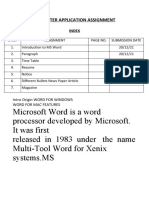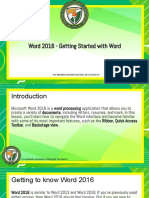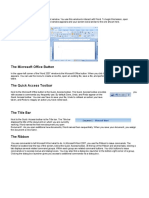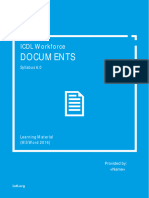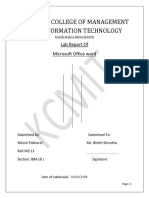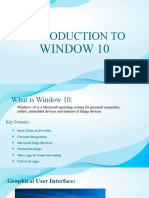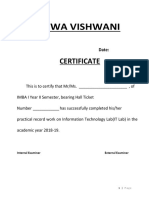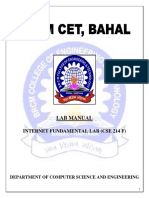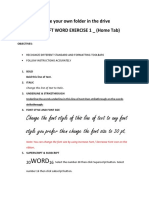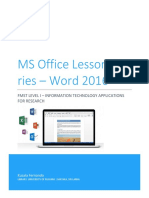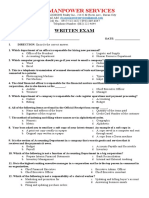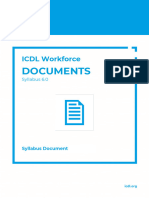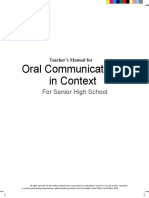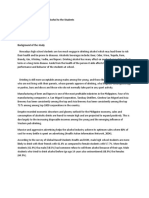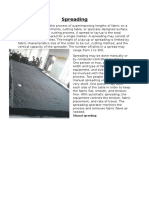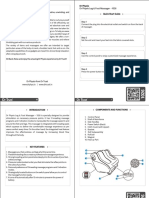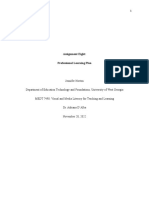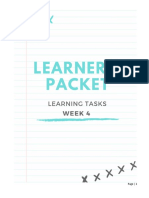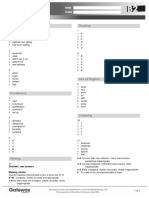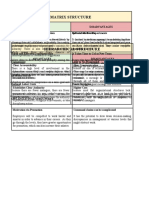ECDL MODULE
ADVANCED
WORD PROCESSING
Syllabus Version 3.0
�Purpose
This document details the syllabus for the Advanced Word Processing module. The syllabus
describes, through learning outcomes, the knowledge and skills that a candidate for the
Advanced Word Processing module should possess. The syllabus also provides the basis for
the theory and practice-based test in this module.
Copyright © 1997 - 2017 ECDL Foundation
All rights reserved. No part of this publication may be reproduced in any form except as
permitted by ECDL Foundation. Enquiries for permission to reproduce material should be
directed to ECDL Foundation.
Disclaimer
Although every care has been taken by ECDL Foundation in the preparation of this publication,
no warranty is given by ECDL Foundation, as publisher, as to the completeness of the
information contained within it and neither shall ECDL Foundation be responsible or liable for
any errors, omissions, inaccuracies, loss or damage whatsoever arising by virtue of such
information or any instructions or advice contained within this publication. Changes may be
made by ECDL Foundation at its own discretion and at any time without notice.
ECDL Foundation is a registered business name of The European Computer Driving Licence Foundation Limited. European Computer Driving Licence, ECDL and
related logos are all registered Trade Marks of ECDL Foundation. All rights reserved.
© 1997-2017 ECDL Foundation Ref: ECDL Advanced Word Processing - Syllabus - V3.0 Page 2 of 6
� Advanced Word Processing
This module sets out advanced skills that can be used to produce complex documents, enhance
outputs, and improve productivity, when using a word processing application.
Module Goals
Successful candidates will be able to:
Apply advanced text, paragraph, column and table formatting. Maintain a consistent design through
the use of character and paragraph styles.
Work with referencing features like footnotes, endnotes and captions. Manage citations and
bibliography using a chosen citation style. Create tables of contents, indexes and cross-references.
Enhance productivity by using fields, forms and templates.
Apply advanced mail merge techniques and work with automation features like macros.
Use linking and embedding features to integrate data.
Collaborate on and review documents locally or online. Apply document security features.
Work with watermarks, sections, and headers and footers in a document. Use a thesaurus and
manage spell check settings.
CATEGORY SKILL SET REF. TASK ITEM
1 Formatting 1.1 Text 1.1.1 Apply text wrapping options for graphical
objects (picture, chart, diagram, drawn object),
tables.
1.1.2 Use find and replace options like: matching
case, whole words, font formats, paragraph
formats, paragraph marks, page breaks.
1.1.3 Use paste special options: formatted text,
unformatted text.
1.2 Paragraphs 1.2.1 Apply line spacing within paragraphs: at least,
exactly/ fixed, multiple/proportional.
1.2.2 Apply, remove paragraph pagination options.
1.2.3 Apply, modify outline numbering in multi-level
lists.
1.3 Styles 1.3.1 Recognise good practice in maintaining
consistent and accessible design and format
throughout a document by using styles,
alternative text.
1.3.2 Create, modify, update a character style.
1.3.3 Create, modify, update a paragraph style.
1.4 Columns 1.4.1 Apply multiple column layouts. Change number
of columns in a column layout.
1.4.2 Change column widths and spacing. Insert,
remove lines between columns.
© 1997-2017 ECDL Foundation Ref: ECDL Advanced Word Processing - Syllabus - V3.0 Page 3 of 6
� CATEGORY SKILL SET REF. TASK ITEM
1.4.3 Insert, delete a column break.
1.5 Tables 1.5.1 Apply a table autoformat/table style.
1.5.2 Merge, split cells in a table. Split a table.
1.5.3 Change cell margins, alignment, text direction.
1.5.4 Automatically repeat heading row(s) at the top
of each page.
1.5.5 Allow, do not allow row(s) to break across
pages.
1.5.6 Sort data by one column, by multiple columns
at the same time.
1.5.7 Convert delimited text to a table.
1.5.8 Convert a table to text.
2 Referencing 2.1 Captions, 2.1.1 Add a caption above, below a graphical object,
Footnotes and table.
Endnotes
2.1.2 Add, delete a caption label.
2.1.3 Change caption number format.
2.1.4 Insert, modify footnotes, endnotes.
2.1.5 Convert a footnote to an endnote. Convert an
endnote to a footnote.
2.2 Citations and 2.2.1 Insert, edit a citation like: book, article,
Bibliography conference proceedings, website, report.
2.2.2 Set, modify citation style.
2.2.3 Create, update a bibliography.
2.3 Reference Tables 2.3.1 Create, update a table of contents based on
and Indexes specified heading styles and formats.
2.3.2 Create, update a table of figures based on
specified styles and formats.
2.3.3 Edit a table of contents, table of figures like:
heading styles, format, leaders.
2.3.4 Mark an index: main entry, subentry. Delete a
marked index entry.
2.3.5 Create, update an index based on marked
index entries.
2.4 Bookmarks and 2.4.1 Add, delete a bookmark.
Cross-References
© 1997-2017 ECDL Foundation Ref: ECDL Advanced Word Processing - Syllabus - V3.0 Page 4 of 6
� CATEGORY SKILL SET REF. TASK ITEM
2.4.2 Create, update, delete a cross-reference to:
numbered item, heading, bookmark, figure,
table.
2.4.3 Add a cross-reference to an index entry.
3 Enhancing 3.1 Using Fields 3.1.1 Insert, delete fields like: file name and path, file
Productivity size, total page number.
3.1.2 Insert a formula field code in a table like: sum,
average, count.
3.1.3 Change field number, date format.
3.1.4 Lock, unlock, update a field.
3.2 Forms, Templates 3.2.1 Create, modify a form using available form field
options: text field, check box, drop-down menu.
3.2.2 Protect, unprotect a form.
3.2.3 Save a document as a template, modify a
template.
3.2.4 Modify the default template.
3.3 Mail Merge 3.3.1 Edit, sort, filter a mail merge recipient list.
3.3.2 Insert ask, if…then…else… fields.
3.3.3 Merge a document with a recipient list using
given merge criteria.
3.4 Linking, 3.4.1 Create a simple chart in a document.
Embedding
3.4.2 Link data from a document, application and
display as an object, icon.
3.4.3 Update, break a link.
3.4.4 Embed data into a document as an object.
3.4.5 Edit, delete embedded data.
3.5 Automation 3.5.1 Modify automatic text formatting options.
3.5.2 Create, modify, delete automatic text correction
entries.
3.5.3 Create, modify, insert, delete automatic text
entries.
3.5.4 Record a simple macro like: change page
setup, insert a table with a repeating heading
row, insert fields in document header, footer.
3.5.5 Run a macro.
© 1997-2017 ECDL Foundation Ref: ECDL Advanced Word Processing - Syllabus - V3.0 Page 5 of 6
� CATEGORY SKILL SET REF. TASK ITEM
3.5.6 Assign a macro to a custom button.
4 Collaborative Editing 4.1 Tracking and 4.1.1 Turn on, off track changes. Track changes in a
Reviewing document locally, online using a specified
display view.
4.1.2 Accept, reject changes in a document locally,
online.
4.1.3 Insert, edit, delete, show, hide comments/notes
in a document locally, online.
4.1.4 Compare and merge documents.
4.2 Security 4.2.1 Add, remove password protection for a
document: to open, to modify.
4.2.2 Protect a document to only allow tracked
changes or comments.
5 Preparing Outputs 5.1 Sections 5.1.1 Create, modify, delete section breaks in a
document.
5.1.2 Change page orientation, page vertical
alignment, margins for sections of a document.
5.2 Document Setup 5.2.1 Apply different headers and footers to sections,
first page, odd and even pages in a document.
5.2.2 Add, modify, remove a watermark in a
document.
5.3 Spelling, 5.3.1 Set, modify default spell check language.
Thesaurus
5.3.2 Use Thesaurus to search, insert alternative
word(s).
© 1997-2017 ECDL Foundation Ref: ECDL Advanced Word Processing - Syllabus - V3.0 Page 6 of 6
















